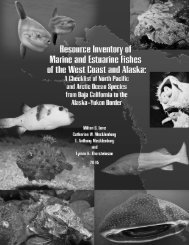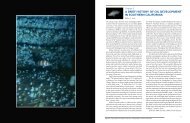Reproductive Ecology and Body Burden of Resident ... - The Love Lab
Reproductive Ecology and Body Burden of Resident ... - The Love Lab
Reproductive Ecology and Body Burden of Resident ... - The Love Lab
Create successful ePaper yourself
Turn your PDF publications into a flip-book with our unique Google optimized e-Paper software.
Sample Collection<br />
Fish species consisted <strong>of</strong> kelp bass (Paralabrax clathratus), kelp rockfish (Sebastes atrovirens), <strong>and</strong> Pacific<br />
s<strong>and</strong>dab (Citharichthys sordidus), which were collected either by spearing or with hook-<strong>and</strong>-line during<br />
July-December 2005 <strong>and</strong> July-August 2006. Brief species accounts (based on Boschung et al. 1983, Eschmeyer<br />
et al. 1983, <strong>Love</strong> 1996, <strong>and</strong> <strong>Love</strong> et al. 2005) are as follows: Kelp bass grow as large as 72 cm, with a<br />
maximum weight <strong>of</strong> about 6.6 kg. This species is substrate-oriented <strong>and</strong> inhabits both the water column <strong>and</strong><br />
sea floor within or near kelp beds, rocky reefs, <strong>and</strong> such human-made structures as oil platforms. It is most<br />
<strong>of</strong>ten found at depths <strong>of</strong> 2.4-30 m although large specimens occur as deep as 61 m. Juveniles feed on benthic<br />
invertebrates (especially crustaceans), whereas adults feed primarily on fishes <strong>and</strong> cephalopods. This is an<br />
excellent food fish <strong>and</strong> an important game fish. Kelp rockfish attain a maximum length <strong>of</strong> about 42 cm, <strong>and</strong><br />
usually occur on or near the bottom in kelp beds or rocky areas. Although commonly found at depths <strong>of</strong><br />
9-12 m, this species can occur as deep as 58 m. Foraging occurs mostly at night on organisms living on the<br />
substrate, such as crabs, bottom-dwelling shrimps, fish, <strong>and</strong> cephalopods. This is an important recreational<br />
<strong>and</strong> minor commercial species. Pacific s<strong>and</strong>dab grow to about 41 cm, <strong>and</strong> inhabit s<strong>and</strong>y <strong>and</strong> muddy bottoms<br />
at depths <strong>of</strong> 9-550 m. It is an opportunistic predator, feeding on a variety <strong>of</strong> crustaceans, as well as smaller<br />
fish, squid, <strong>and</strong> octopus. S<strong>and</strong>dabs are a popular food fish in California.<br />
Immediately following capture, fish were weighed <strong>and</strong> measured for total length (TL), assigned a<br />
unique identification number, then wrapped <strong>and</strong> bagged in clean plastic <strong>and</strong> held on wet ice until returning<br />
to the laboratory. In the laboratory, fish samples were stored frozen (-10°C) for roughly 1 week to 6 months<br />
until shipment to the U.S. Geological Survey (USGS) Columbia Environmental Research Center (CERC),<br />
Columbia, Missouri, for further processing <strong>and</strong> analysis.<br />
Sample Preparation<br />
Frozen samples held in coolers with dry ice were transported by overnight air freight to CERC. At<br />
CERC, frozen fish weighing 100 g but 300 g were also cut into pieces with<br />
the Hobart b<strong>and</strong> saw <strong>and</strong> homogenized with a Hobart meat grinder. All samples were processed through<br />
the meat grinder three times, collected in a plastic bag, then h<strong>and</strong>-kneaded to facilitate mixing <strong>and</strong> produce<br />
a homogenized mass. A portion <strong>of</strong> the resulting ground product was placed in a 118-ml cleaned glass jar<br />
<strong>and</strong> archived for future organic contaminant analysis. A second ground portion was placed in a 118-ml jar<br />
equipped with a filter lid for lyophilization. All filter-lid aliquots were lyophilized in a Virtis Genesis 35EL<br />
freeze dryer, with moisture content determined during the lyophilization process. After lyophilization, each<br />
dried fish sample was transferred to a plastic bag <strong>and</strong> further reduced with a Teflon® roller pin to a coarse<br />
powder. This final product was then transferred to a 40-ml glass vial that was sealed <strong>and</strong> stored in a desiccator<br />
until further processing. To prevent cross-contamination, all equipment used to process a fish sample<br />
were cleaned before processing the next fish sample.<br />
Chemical Preparation<br />
To prepare digestates from dried samples for semi-quantitative scans <strong>of</strong> multiple elements <strong>and</strong><br />
quantitative determinations <strong>of</strong> total arsenic by inductively coupled plasma mass spectrometry (ICP-MS), an<br />
aliquant <strong>of</strong> each sample (~0.25 g) was heated with 6 ml <strong>of</strong> nitric acid in a sealed low-pressure Teflon® vessel<br />
by using a microwave oven. <strong>The</strong> cooled digestate liquid was transferred into a 125-ml polyethylene bottle<br />
with ultrapure water (>10 megOhm/cm) to a final weight <strong>of</strong> 101.5 g (100 ml). Final acid matrix was 6%<br />
nitric acid.<br />
5




